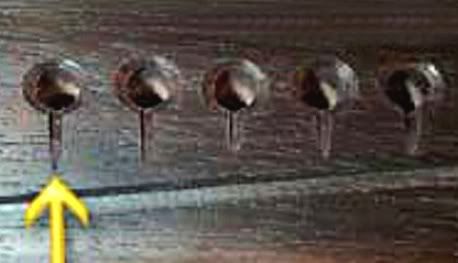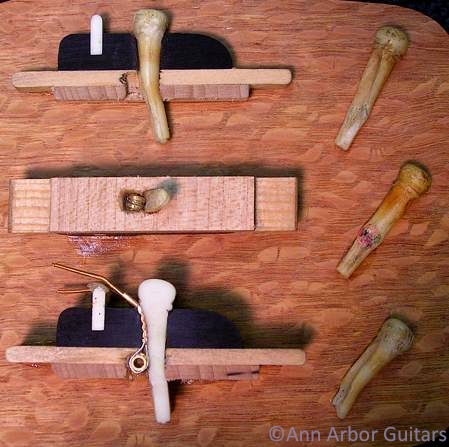Quote:
Originally Posted by redir

Typically a key hole slot is cut in the hole to allow the string to ramp up out of the hole to the saddle and the ball end of the string will sit tightly to the bridge plate on the inside of the guitar. You don't need fluted pins with key holes.
This can be done to most guitars even cheap ones with a keyhole saw and some files. You probably don't have access to a reamer but what you can do is find a 10in (or so) ******* file. Look at the file handle end and size it up to the taper on your bridge pin. If it's close then you can use that to ream out the holes. Do it carefully and slowly checking all the time to see if the pin seats well and is held in by friction.
|
Just trying to clarify here: I think there are two procedures mentioned, one is "slotting" - what you refer to as a "key hole slot" and the other is "ramping," which is the "ramp up out of the hole to the saddle" reference?
Again, just to clarify, ramping is a shallow horizontal slot running away from the top of the hole toward the bridge. It is designed to help increase the "break angle" of the string over the saddle. Ramping is not designed to help seat pins.

Typically, most guitars - and certainly new or late model ones - should not need to be ramped: they either all ready are or are built not to be. Their break angles should be just fine.
The procedure to seat pins is called "reaming" (or one can buy a set of smaller pins). Reaming is best done with a
fluted reamer of the desired taper (usually 5-degrees for Martins - or 3-degrees for some other brands). If you do decide to ream the holes, use the proper type of reamer, or have a tech do it for you. Takes about five minutes.
I think the "fluted pins" you reference are usually referred to as "slotted" as opposed to "unslotted." Slotted pins are used when the bridge pin holes have not been slotted. If they have, then one can use unslotted pins, or turn slotted pins around. Bridge pin-hole slots are vertical grooves through the bridge, top, and plate, whereas ramps are horizontal.

Slotting the bridge is done to help prevent possible future damage to the bridge plate and to help prevent pins from bending or chipping.

 (photo by David Collins)
(photo by David Collins)
Personally, I like my pins to sit on their collars as designed. The bridge looks neater, the pins shafts are all the way down helping to keep the string balls from working their way up the holes, and they don't bother me when I palm mute my strings.